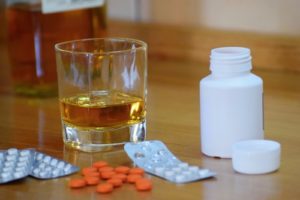All drugs come with their own risks, whether they are legal or illegal. But what happens when two powerful substances, such as alcohol and prescription opioids, are mixed and how does that combination affect the body and brain?
Each substance is dangerous when they are misused or abused independently. When they are abused together, however, the risks increase significantly, and people who engage in it are taking chances with their health and their lives.
In short, mixing alcohol with opioids or opiates can affect the body in various ways and lead to overdose and death.
Opiates/Opioids
Opiates and opioid medications are typically prescribed to treat pain that results from surgery or injury. Medications in this class include:
- Codeine
- Darvocet
- Dilaudid
- Demerol
- Fentanyl
- Hydrocodone (Vicodin)
- Methadone
- Morphine
- Oxycodone
- OxyContin
- Percocet
- Suboxone
- Tramadol
Opiates also include the illegal drug heroin, which is made from morphine. Opiates and opioids both act on receptors in the brain that change the way it perceives pain. People who use them will feel little to no pain after taking these medications. When used as directed, opiates/opioids can be effective and help people manage their health challenges. But when people start taking the medications more often than prescribed, or when they start to abuse them in ways that are inconsistent with their purpose, that’s when the problems start.
As the National Institute on Drug Abuse writes, “When properly managed, short-term medical use of opioid pain relievers—taken for a few days following oral surgery, for instance—rarely leads to an opioid use disorder or addiction. But regular (e.g., several times a day, for several weeks or more) or longer-term use of opioids can lead to dependence (physical discomfort when not taking the drug), tolerance (diminished effect from the original dose, leading to increasing the amount taken), and, in some cases, addiction (compulsive drug seeking and use).”
Misusing and abusing opioids have both contributed to the public health crisis the United States is facing right now. According to data cited by the National Institute on Drug Abuse, about 21 percent to 29 percent of people who have been prescribed opioids for chronic pain misuse them. Also, between eight percent and 12 percent develop an opioid disorder. In some cases, prescription misuse leads to heroin use. About 80 percent of people who use heroin first misused prescription opioids, according to this data review.
When people abuse opiates/opioids, they encounter effects such as:
- Mental confusion
- Constricted pupils
- Nodding off to sleep at times
- Slower breathing rate
- Loss of consciousness
Constipation, nausea, vomiting, itching, and drowsiness are all signs of opiate/opioid abuse.
Alcohol
Alcohol, a depressant, is commonly abused with other drugs. When it is abused with opiates or opioids, it further depresses a person’s nervous system and slows their heart rate and breathing rate. The sedative effects of alcohol often make it difficult to gauge when they have had too much to drink. This means they may not be aware of how much opiate/opioids they have taken, pushing them closer to danger.
Alcohol Intoxication Signs Include:
- Mental Confusion
- Dulled senses
- Blurry, double vision
- Slurred speech
- Memory lapses
- Dizziness
- Mood swings
- Impaired judgment
- Slow reaction times
- Drowsiness, sleepiness
- Physical coordination loss
- Poor motor skills
- Irregular heartbeat
If you or someone you know engages in these practices or exhibits any of these signs, consider getting professional help to end your chemical dependence on these substances.
Short-Term, Long-Term Effects of Alcohol, Opiate Use
Users who take opiates and drink alcohol at the same time will feel the effects of both of these drugs once they are in their systems. Alcohol is commonly abused with other drugs among substance users. Sometimes it happens by accident when people drink alcohol after taking their opioid prescription medication as directed. But in most cases, people willingly engage in alcohol and opiate abuse because they want to enhance the euphoric high they get from pain relievers. However, this combination is never a good idea. People who mix the two increase their chances of having an overdose, which can be fatal.
There are short-term effects and long-term effects that result from combining alcohol with opioids or opiates. When people use the substances together, they might experience short-term effects such as:
- Euphoria
- Confusion
- Dizziness
- Nausea
- Vomiting
- Dehydration
- Rushed emotional state
- Sleepiness, drowsiness
- Detachment
- Anxiety
- Apathy
- Delayed movements
- Depressed breathing (slow breathing)
- Fainting, losing consciousness
- Numbness
- Concentration difficulties
- Possible seizures because of low blood sugar
Long-term use of alcohol and opiates/opioids can increase a person’s tolerance to both substances. This means the person will have to use more of each to experience the same highs they once did, which also increases the chance of overdose. Other effects stemming from long-term abuse include:
- Increasing substance use to satisfy cravings, tolerances
- Mood swings, irritability
- Memory loss increased dementia risks
- Permanent brain damage
- Coma
- Death
Dangers of Alcohol-Opiate Abuse
Opiates/opioids and alcohol both depress the central nervous system and slow a user’s breathing and heart rate. These conditions can result in not enough oxygen getting to vital organs, such as the heart and the brain, which can cause damage, injury, and death.
Alcohol and opiate users are also at increased risk of injuries, such as falls, because their substance use can cause them to lose their physical coordination. They also are at a greater risk of exhibiting impaired thinking.
Everyday activities such as driving and cooking should be avoided as a loss of coordination and clouded judgment can lead to injury or worse.
The presence of both of these substances in large amounts also can harm the body. Regular alcohol-opiate users can weaken their immune systems, strain their cardiovascular and respiratory systems, and worsen any mental health issues or medical illnesses that may either know or not know about.
Treating Alcohol and Opiate Addiction
Addiction treatment is available for alcohol-opiate addiction. Withdrawal symptoms from each substance may intensify as both substances leave the bloodstream when someone stops using them. It is common for chronic users to have two sets of withdrawal symptoms that are different from each other.
Affected users may feel like they have symptoms akin to the flu with challenging psychological side effects as a result of opioid withdrawal. But their withdrawal symptoms from alcohol can turn more serious quickly.
 They require close attention because, if not treated properly, they are at risk of seizures or delirium tremens, a severe condition that involves mental confusion, shaking, and hallucinations.
They require close attention because, if not treated properly, they are at risk of seizures or delirium tremens, a severe condition that involves mental confusion, shaking, and hallucinations.
This condition can be fatal, so it is strongly advised that alcohol-opiate users who are withdrawing from both substances undergo and complete medical detoxification at a licensed drug or alcohol treatment.
This three- to 10-day process involves 24/7 monitoring from medical professionals who are there to get clients through the challenging withdrawal process and keep them as safe and comfortable as possible.
Recovering users may be put on a drug tapering schedule to gradually reduce the substances until they regain medical stability. They also may be given medications to help ease their symptoms.
Detox is the first step of treatment. After that, an evaluation is made to ensure that a proper diagnosis is made and the right program is chosen that addresses all of a person’s medical and psychological needs.
Depending on the situation and the recovering user’s independent needs, professionals can recommend an inpatient treatment or residential treatment program that can last from 28-90 days in a facility. While there, recovering alcohol-opiate users can receive a variety of therapies to address the psychological side of addiction in addition to the physical side of it.
NIDA advises that people in recovery spend at least 90 days, or three months, in rehab to increase their chances of having a successful rehab experience and lasting results. A professional rehab also connects clients with aftercare services that can help them manage their new sobriety by helping them find transitional housing, employment, and support groups that can provide emotional support and help with long-term withdrawal symptoms known as Post-acute withdrawal syndrome (PAWS).
How Alcohol, Opiate Use Can Complicate Treatment
Alcohol-opiate use also further complicates treatment in that emergency workers and other medical professionals have to figure out how to best remove both substances from one’s system, particularly in overdose cases. The overdose-reversal drug naloxone (brand-name Narcan) can be given to counter the opiate effects, but it has no bearing on the alcohol the person has ingested.
Get Help for Alcohol and Opiate/Opioid Addiction
If you or someone you know is addicted to mixing alcohol with opioids or another substance, do not hesitate to seek help now. Once dependence and addiction set in, it is difficult to stop on your own. It also is dangerous as the chances of relapse are high. Delphi Behavioral Health Group can assist you in finding the right treatment program that suits your individual needs. We’re available 24/7 at (844) 913-2009 and ready to guide you on the beginning of your recovery journey. It’s never too late to regain control of your life, so why wait? Treatment programs at Delphi Behavioral Health Group’s facilities provide unique therapy and counseling methods for certain addictions. They are designed to allow you to receive the daily support of the facility’s staff and your loved ones when you return home. Our treatment centers provide just what’s needed for community, counseling, and support throughout the day so clients can apply the lessons they learn to their lives.

